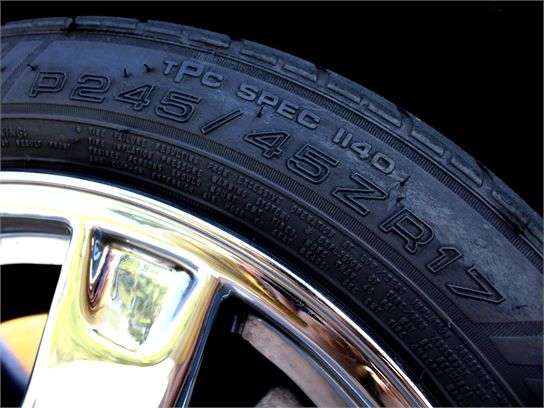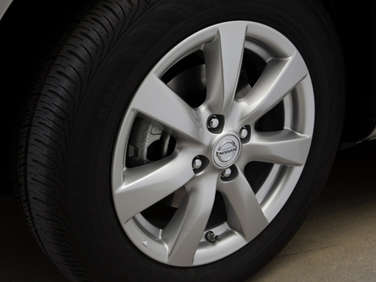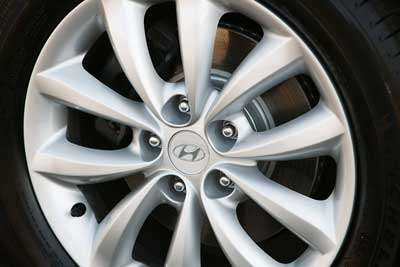Recent Articles
Popular Makes
Body Types
What Are Low Rolling Resistance Tires?

One of the fundamental laws of physics is that an object at rest tends to want to stay at rest, while an object in motion tends to want to stay in motion. When your car is sitting still, a significant amount of the energy it produces must be expended to set it in motion.
Ironically, by their very nature your tires tend to want to resist rolling. After all, they are also responsible for stopping your car, as well as holding it to road when you change directions. In order to get your tire moving, it is estimated that from five to 15 percent of your fuel consumption goes to overcoming your tires’ rolling resistance.
In an effort to reduce fuel consumption, tire manufacturers have developed what are known as low rolling resistance tires. Through observing the behavior of a tire as it wears, manufacturers noticed that a worn tire demonstrates less rolling resistance than a new one. However, the trade-off is reduced handling and braking capability, which of course could lead to dangerous situations.
Low rolling resistance tires return better fuel economy, without the trade-offs in handling and braking capability.
Low Rolling Resistance Tires: How They Work
Tires must deform slightly to produce their contact patch (the part of the tire that interacts with the road surface) in order to work properly. The amount of energy required by the tire to deform is called rolling resistance. Tires that have a low rolling resistance require less energy to deform into the contact patch. By reducing the energy lost through the use of low rolling resistance tires, cars can demonstrate reduced fuel consumption and lower emissions.
Early iterations of the low rolling resistance tire (LRR) were constructed from a very hard rubber compound and featured very stiff sidewalls in an effort to reduce friction with the road surface and the flexing of the tires accompanying this deformation. There was a downside though. The problem with this reduced flex was it also translated into a harsher ride.
Another factor is the heat generated by friction and flexion. These properties absorb energy that could be put to better use moving the car. When a tire rolls it flexes as weight is placed on it and then it snaps back into shape as it rolls along. This generates heat in the tire. The problem is the energy it takes to flex the tire that was ultimately lost as heat could be used to actually move the car too.
Newer, silica-based compounds and alternative oils and emulsifiers used in LRR tires are reducing rolling resistance while still providing a comfortable and smooth ride. They also run cooler so less energy is lost as heat. They are demonstrating the ability to provide improved grip.

Low Rolling Resistance Tires: Alternatives
Truth be told, compared to the days of old, all modern tires are LRR tires.
The earliest significant improvement in fuel economy to be associated directly with tires came with the introduction of the radial tire back in 1946. The construction of the inner carcass of radial tires makes them less resistant to rolling than the previously used bias ply tires. Because the inner construction of the radial tire generates less friction, it rolls more easily. A radial tire also weighs less than a comparably-sized bias-ply tire, which in turn reduces the overall weight of the vehicle it's mounted upon.
Even within the ranks of conventional modern radial tires, some resist rolling less than others. Manufacturers routinely fit new models with lower rolling resistance tires than what are typically fitted to the car in the replacement, or aftermarket. They do this to improve corporate average fuel economy ratings. As you might have guessed, LRR tires are more expensive. So when drivers look to replace their OEM tires, sometimes replacement cost wins out over the desire to be environmentally responsible.
Fortunately, there are measures a driver can take to help their tires improve fuel economy and reduce their environmental impact — without switching to a formal “ low rolling resistance tire”.
These include paying attention to:
- Tire Pressure – Tires designed to operate at higher pressures reduce the deformation of the tire, causing it to consume less energy.
- Rubber Compounds – Harder and lighter compounds do not deform as much, thus requiring less energy, while still delivering an acceptable ride and competent handling and braking.
- Dimensions – Narrow, low profile tires generally require less energy to deform becaus eof their reduced mass.
- Weight – Tires with less material require less energy to deform and reduce the unsprung weight of the vehicle. This has the added benefit of improving handling.
- Tread Pattern – Smooth tread patterns roll more easily than coarse tread patterns. Short lugs and narrow gaps improve rolling resistance, while also delivering a quieter driving experience.
- Compounding Methods – Using alternatives to toxic oils during fabrication helps reduce the environmental impact of tires both during their useful service life and when it's time to recycle them
Purchasing tires with these factors in mind will help your vehicle achieve better fuel economy while simultaneously reducing its environmental impact.
